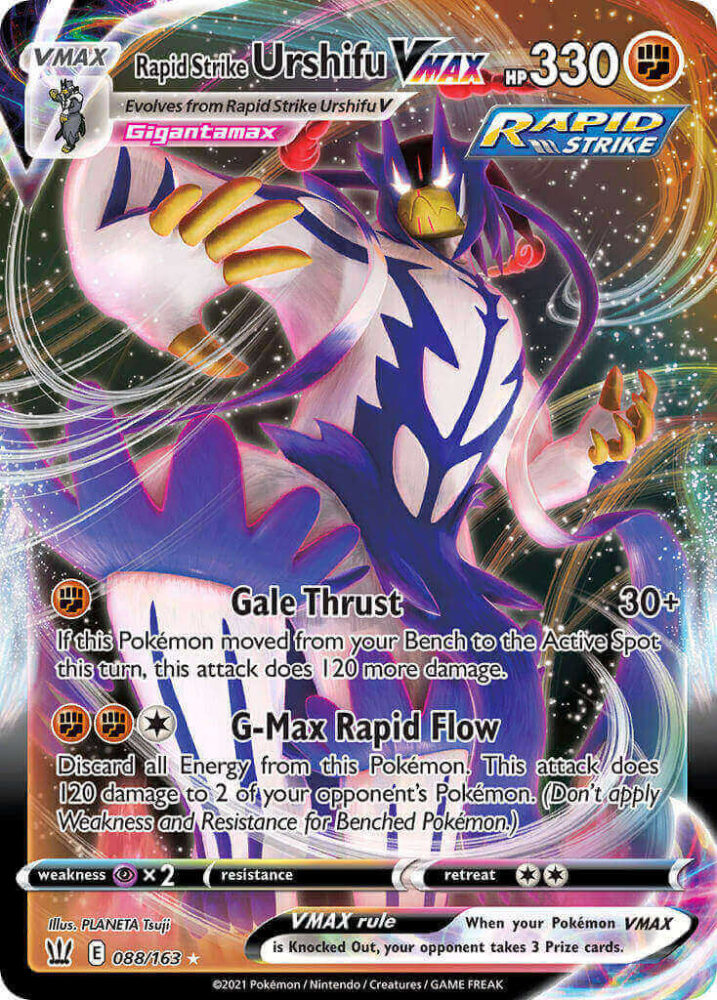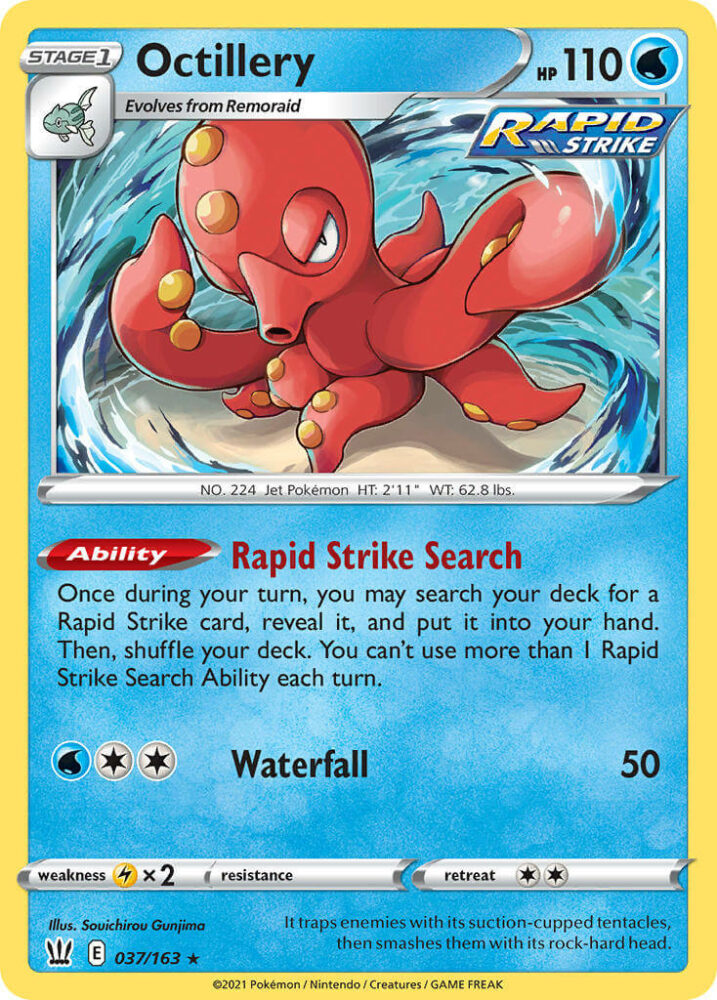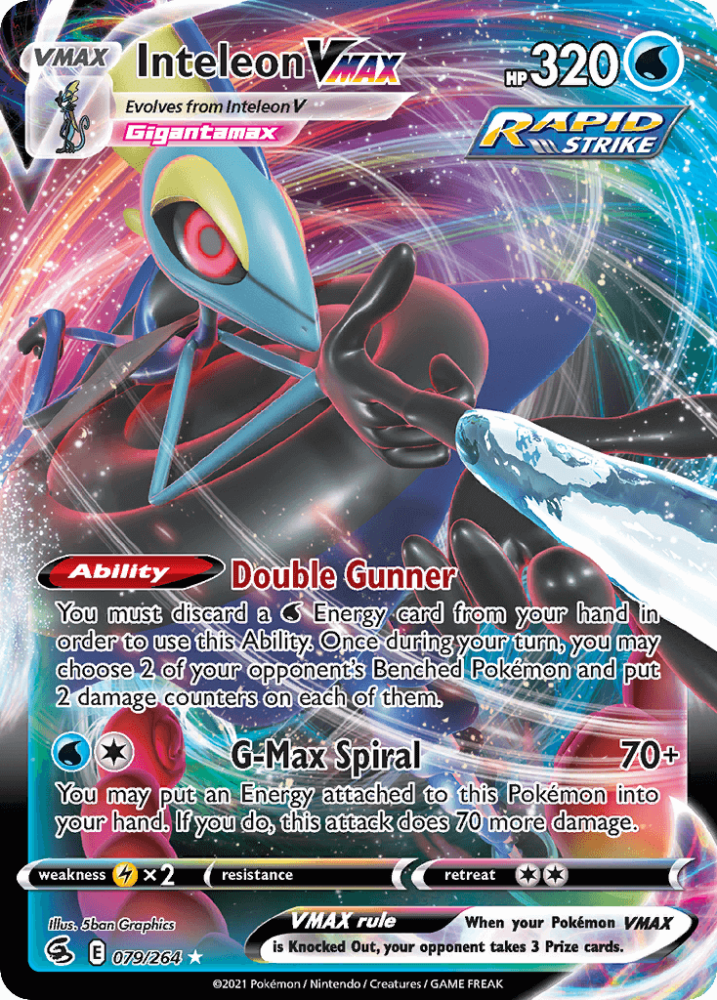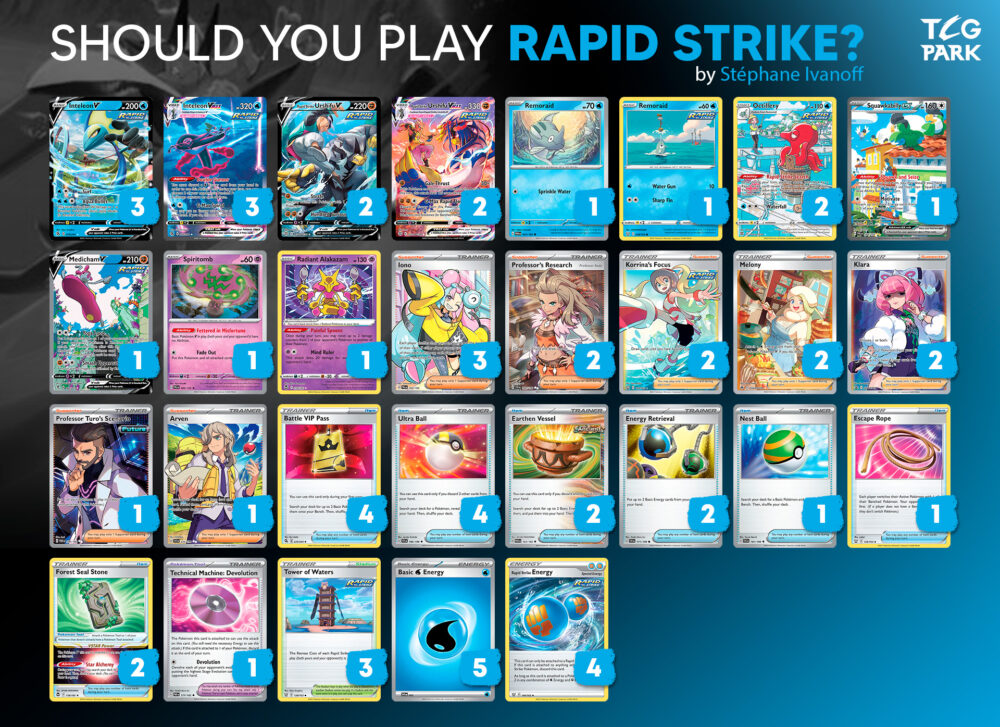Rapid Strike Urshifu VMAX has a surprising competitive history. It was released in Battle Styles, in what is now known as the pandemic era. At that time, the competitive circuit was on hold. Nevertheless, in the few official online tournaments (the Players Cup and Team Challenge) and many unofficial ones, it performed very well, paired with Jirachi (Team Up), then Inteleon (Chilling Reign) when it came out. When Fusion Strike released, Urshifu found a terrifying enemy in Mew VMAX, the new BDIF, which hit it for Weakness and wasn’t afraid of what Rapid Strike Urshifu VMAX brought to the table. The nature of low-stakes online tournaments meant that Urshifu was still seeing play, as many players chose to use varied decks rather than Mew VMAX, but nevertheless, Urshifu suffered, taking a terrible matchup against the best deck around.
Then Brilliant Stars came out and IRL tournaments resumed in March 2022. There was still this notion that Rapid Strike Urshifu VMAX was hampered by a bad Mew VMAX matchup, but in Liverpool, the first European Regionals in this format, something unexpected happened. The LimitlessTCG testing group came up with a new build for the deck, using Dark Energy and Galarian Moltres, plus Klara, to face Mew VMAX. Robin Schulz used this deck to win Liverpool Regionals, putting Urshifu on the map once again.
It was definitely not the first time that someone thought to combine Urshifu with Dark Energy, but this new build was hyped as revolutionary because it looked so strange: it played a total of nine Supporters, all different from each other (including a Peonia), a 1-1 line of Octillery, and even Snorlax VIV for more early game draw, with the Inteleon line ensuring that this strange concoction remained consistent.
Because of that list, Urshifu gained a reputation for being a complicated deck, that needed a lot of practice to play correctly. Even as it dominated EUIC, picking up five spots in the top 8 in the hands of some of the absolute best players in the game, its general win rate, as evidenced by online events, was low; it was a deck that competitive players had to respect, but that couldn’t simply be picked up on a whim.
As new sets came out, Urshifu faded in popularity; it didn’t just need to deal with Mew VMAX now, it was also threatened by powerful new archetypes: Palkia VSTAR, then Giratina VSTAR and Lugia VSTAR. After rotation, Rapid Strike Urshifu VMAX lost its main partner, the Inteleon line (Drizzile and Inteleon SSH rotated, so even though Inteleon CRE was still around, there was no point running it), so players adapted and paired it with Inteleon VMAX. This new variant didn’t catch on; there were a handful of players using it in day 2 of many major events, but that was nothing compared to the popularity of decks like Lost Box, Lugia VSTAR or Gardevoir ex.
Then Paldea Evolved, and Cyrus Davis won NAIC with Urshifu. Even after that huge achievement, though, Urshifu remained somewhat uncommon. It definitely gained in popularity after that, and managed to get some great results, including a win at the Barcelona SPE at the beginning of the season. However, while it tends to have a good conversion rate at every major event, and can often be seen at top tables, Urshifu remains less played than a deck of its stature probably should.
I think there are two factors that can explain this. First, the reputation it gained for being hard to play still follows it, to some extent. For a long time, I felt that it wasn’t worth learning to play Urshifu, as it was not a top tier deck, and my time would be better spent getting better at other archetypes, like Gardevoir. Urshifu gained some new cards in Paradox Rift that make it more consistent, though, and it’s also in a better place in the metagame than before. Also, the current version is not that hard to play! It’s obviously not an autopilot deck, but it’s not considerably harder than most of the metagame.
The second factor is that Urshifu has very polarized matchups, with great matchups against some popular decks (Gardevoir, Miraidon, Charizard…) and very bad matchups against others (Mew, Snorlax, Roaring Moon…). Many players would rather play a deck which has great matchups overall, than one which depends heavily on what you face.
However, I think that this is inevitable in the current metagame. Pretty much every good deck has a glaring weakness (Charizard loses to Snorlax, Mew loses to Charizard, etc.), except for Gardevoir and Giratina, which have generally even matchups, but instead have the issue of not having the time to finish a best of three match in 50 minutes.
Basically, even though it will rotate soon, Rapid Strike Urshifu VMAX is probably in the best spot it’s ever been in. If, like me, you hesitated to give it a try, I recommend you do so! In this article, I’ll try to explain the basics of the deck, to get you started. I’ll admit that I’m not an Urshifu expert, so if you’ve been playing the deck for a while, you might find this guide unhelpful; sorry, Rapid Strike devotees, you’re not the target audience for this one (but if you do read it, I hope you find it interesting anyway)! For everyone else, let’s get started.
The basics



At its core, the deck relies on two attackers and a support Pokémon: Inteleon VMAX and Rapid Strike Urshifu VMAX, and Octillery. Inteleon VMAX is the main attacker. Its 140 damage, even if it’s only for the cost of a Rapid Strike Energy, is far below the damage output of most other popular decks, but Inteleon VMAX’s Ability Double Gunner makes up for it, letting it add more damage to the opponent’s board. Rapid Strike Urshifu VMAX acts as a finisher: often, it only attacks once, to end the game with G-Max Rapid Flow (powered in one turn thanks to Rapid Strike Energy and Melony). Octillery is a great support Pokémon, as it allows the player to search for its attackers, Energy, and some other cards like Tower of Waters, which is necessary both to counter Path to the Peak and to allow for mobility between the deck’s various pieces. Octillery can also search for Korrina’s Focus: even though it is, in general, not a great Supporter, its inclusion in this deck is necessary because it turns Octillery’s Rapid Strike Search into draw power, which can let a player draw out of a bad hand.
The main element of this Rapid Strike deck, that separates it from other archetypes, is its reliance on residual damage. No other deck (not even Iron Valiant ex!) can add damage as efficiently to the opponent’s Bench. Inteleon VMAX’s Double Gunner adds 40 damage to the opponent’s Bench. If you have two of them in play, which is usually what you want, that’s 80 damage that can be added. Radiant Alakazam can move this damage around, and Medicham V’s Yoga Loop can finish off a Pokémon with 20 HP left, allowing you to play an additional turn, during which you can use Double Gunner and put even more damage on the field… this can add up very quickly. This all requires Water Energy, of course, but between Earthen Vessel, Energy Retrieval, and Klara, there are several ways to get multiple Energy in hand.
The ease with which Inteleon VMAX can damage and KO Benched Pokémon makes it extremely effective against decks with Pokémon that have 80 HP or fewer, such as Lost Box, or evolving decks like Gardevoir and Charizard. Also, the fear of G-Max Rapid Flow will often force the opponent to Bench Manaphy, which is an additional target that can be taken out for an easy Prize. A common play against a deck like Gardevoir is to use Double Gunner and Radiant Alakazam to weaken Manaphy, take the KO with Yoga Loop, then on the next turn, power up Rapid Strike Urshifu VMAX and KO two other Pokémon with G-Max Rapid Flow, for a huge game-ending turn.
Some decks also play Jirachi, which protects Benched Pokémon from Yoga Loop. In that case, the plan is to fill the board with damage thanks to Double Gunner, then in one turn, KO Jirachi with Double Gunner and/or Radiant Alakazam, then Manaphy with Yoga Loop, and then use G-Max Rapid Flow.
The latest addition to this residual damage strategy is Technical Machine: Devolution. If the opponent has managed to evolve into high HP Pokémon, you can always put damage counters on the opponent’s board, then use Devolution to turn these high HP Pokémon back into their low HP Basic or Stage 1 forms (Kirlia, Charmander, etc.). If you put enough damage on the board, you can effectively get rid of all their attackers this way!
On the flip side, Rapid Strike is less effective against decks with only high HP Pokémon, such as Mew VMAX or Lugia VSTAR. Against these decks, residual damage is much less effective since you can’t take additional Prizes on small Pokémon, and they tend to be bad matchups for the deck. The exception is if Rapid Strike can hit the other deck for Weakness, such as in the Miraidon ex and Iron Valiant ex / Entei V matchups.
Building the deck
While there are some rare variations, there is a consensus on how the deck should be built, generally. Here’s a typical decklist to get you started:
| Pokemon | Trainers | Energy |
|---|---|---|
| 3 Inteleon V FST 78 | 3 Iono PAL 185 | 5 Water Energy 3 |
| 3 Inteleon VMAX FST 79 | 2 Professor’s Research SVI 189 | 4 Rapid Strike Energy BST 140 |
| 2 Rapid Strike Urshifu V BST 87 | 2 Korrina’s Focus BST 128 | |
| 2 Rapid Strike Urshifu VMAX BST 88 | 2 Melony CRE 146 | |
| 1 Remoraid PAR 33 | 2 Klara CRE 145 | |
| 1 Remoraid BST 36 | 1 Professor Turo’s Scenario PAR 171 | |
| 2 Octillery BST 37 | 1 Arven SVI 166 | |
| 1 Squawkabilly ex PAL 169 | 4 Battle VIP Pass FST 225 | |
| 1 Medicham V EVS 83 | 4 Ultra Ball SVI 196 | |
| 1 Spiritomb PAL 89 | 2 Earthen Vessel PAR 163 | |
| 1 Radiant Alakazam SIT 59 | 2 Energy Retrieval SVI 171 | |
| 1 Nest Ball SVI 181 | ||
| 1 Escape Rope BST 125 | ||
| 2 Forest Seal Stone SIT 156 | ||
| 1 Technical Machine: Devolution PAR 177 | ||
| 3 Tower of Waters BST 138 |

Some quick commentary:
- Inteleon and Urshifu lines: As Inteleon VMAX is the main attacker of the deck, and we want two of them in play in most matchups, a 3-3 line is ideal. Urshifu, on the other hand, is only used in the late game, so we’re fine with a thinner line.
- Remoraid: There are two Remoraid in the format. One is a Rapid Strike Pokémon, so it gets free retreat from Tower of Waters, and can be searched by Octillery. The other has 10 more HP, making it safer in the mirror match and against Iron Valiant ex. Players disagree on which one to run, and since it rarely matters, there hasn’t been a consensus. I like having one of each. This way, I can still search for the 70 HP Remoraid with Battle VIP Pass or Nest Ball, but my odds of starting with it are a bit lower (if you start Remoraid, you usually want to retreat it if your opponent can KO it on turn 1), and I can still thin my deck by searching for the Rapid Strike Remoraid with Rapid Strike Search if necessary later in the game.
- Squawkabilly ex: Some players opt to run Lumineon V instead, but Squawkabilly is better on the first turn on the game, especially when going first (which is what Rapid Strike wants to do), and a good first turn is extremely important for this deck: if you set up well in the early turns, your board becomes extremely difficult to answer for most decks.
- Spiritomb: This card is used to improve the Mew VMAX matchup. Most Mew VMAX decks are Fusionless now, and are hurt a lot by Spiritomb. Even with Spiritomb, it remains a difficult matchup, but Spiritomb gives you a better shot.
- Supporters: The main difference between Rapid Strike and other decks is the lack of Boss’s Orders. The deck already has so many ways to deal damage to Benched Pokémon that Boss’s Orders is not necessary (in fact, Counter Catcher would probably be better). Some builds used to run Irida, but it was found fairly underwhelming overall, and most players agree that focusing on draw Supporters (Professor’s Research, Iono and, to a lesser extent, Melony, which is mostly here to power up Urshifu in one turn) is better. Klara is a fantastic card that can offset the discard from Professor’s Research and Squawkabilly ex, and can also recover Energy to use Double Gunner again. Professor Turo’s Scenario replaces Cheryl as a healing card for Inteleon VMAX, and can also be used to remove Squawkabilly ex or another unwanted Pokémon from play to make space for more important Pokémon, like Medicham V or Urshifu. Finally, Arven is, like Irida, often underwhelming, but being able to find Forest Seal Stone (in the early game) and TM Devolution (in the late game) gives it some interesting value.
- Energy: 5 Water Energy is fairly low, but with Earthen Vessel, you can still find them quickly during a game. Once they’re out of your deck, Energy Retrieval becomes extremely effective. Earthen Vessel might not be the most flashy card, but it’s probably the best addition to the deck from Paradox Rift, making it that much faster and more consistent.
A quick matchup guide
Finally, let’s discuss some of Urshifu’s main matchups. As I mentioned early on, this deck has fairly polarized matchups, but that doesn’t mean you can do anything you want and win!
Charizard ex (Favored): Against Charizard ex, you can use your full array of residual damage options to threaten their board. Ideally, you can start taking KOs before their board is established, but usually, they’ll set up Pidgeot ex and Charizard ex on turn 2. If there’s enough easy targets (like Lumineon V) to take Prizes without having to deal with Charizard ex, then you can do so, although be wary of Collapsed Stadium and Professor Turo’s Scenario. Usually, the best plan though is to take some Prizes, then finish the opponent with a big multi-Prize turn (or double turn, thanks to Yoga Loop), using Technical Machine: Devolution to turn Charizard back into Charmander. For example, if you hit the Active Charizard ex once for 140 damage, and put damage on Charizard and Pidgeot with a couple of Double Gunner (and Radiant Alakazam), you can then use Devolution to take three Prizes in one turn. If you Yoga Loop a Charmander or Manaphy on the Bench before, that’s one additional Prize. You should be able to win the game this way; even if you don’t, if your opponent has no board left, they can’t do anything. Just be careful not to take too many Prizes too fast: if you take four Prizes, for example, the opponent could use Charizard ex with a Defiance Band to OHKO your Inteleon VMAX or Urshifu VMAX. Taking Prizes too fast also exposes you to Iono. Finally, good Charizard players will usually target Octillery, so try to set up a second one for safety.
Gardevoir ex (Favored): The same idea applies against Gardevoir ex. Since they need to take damage to deal damage, the matchup is even better for you. However, remember that Urshifu and Medicham have Psychic weakness, so don’t evolve your Urshifu V into a VMAX, since it can be easily KO’d by Gardevoir ex for three Prizes. Focus on getting rid of Ralts and Kirlia. One card you should keep in mind is Cresselia. Not every Gardevoir plays it, but if your opponent does, you need to avoid spreading damage too much, or they’ll heal it and damage you in the process. Try to focus your Double Gunner damage to one or two targets, usually Ralts or Kirlia. As in the Charizard matchup, if the opponent manages to evolve a lot of their Pokémon, Devolution can be very effective in the late game.
Miraidon ex (Favored): Another very popular deck, Miraidon, is also a positive matchup for Rapid Strike, although for very different reasons. In this matchup, forget about Inteleon VMAX: it’s weak to Lightning and would be easily KO’d by any of the opponent’s attackers. If you happen to start with Inteleon, simply don’t evolve it. Instead, set up two Urshifu and Octillery, and KO an attacker every turn with Gale Thrust for two Prizes. If they use a one-Prize attacker, like Zapdos, you can Escape Rope around it or use G-Max Rapid Flow to KO Zapdos and Flaaffy.
Giratina VSTAR (Even): This matchup is more complicated than the previous ones. You can deal with Comfey pretty easily, but the opponent will likely avoid Benching too many Comfey, if any, and instead use Abyss Seeking to fill up their Lost Zone. If they draw well, they can threaten you very quickly, using Star Requiem to take a KO and Lost Impact + Sableye to take the other one. Use Inteleon VMAX to damage Giratina. If they retreat it, you can still threaten to use G-Max Rapid Flow to finish it off. Avoid evolving your Urshifu V if possible, so that if the Giratina player chooses to use a Boss or Counter Catcher to get rid of it, they only take two Prizes, not three. If possible, again, keep Forest Seal Stone to search for Professor Turo’s Scenario, which is huge to heal a VMAX that was damaged by Lost Impact. Data suggests that Urshifu wins this matchup more often than not, but in my experience it’s not that easy against a good Giratina player.
Mew VMAX (Unfavored): In this matchup, set up Spiritomb as early as possible, assuming it’s the Fusionless version. If you’re lucky, this will make the opponent brick, giving you a head start. If they manage to set up, though, the matchup is harder, even if you get Spiritomb in play, because you can’t 2HKO a Mew VMAX. You need Radiant Alakazam to move damage from a Benched Pokémon to Mew VMAX while hitting with Inteleon VMAX, putting Mew at 160 remaining HP. Then, on the next turn, you can use Radiant Alakazam again to move two more damage counters, and finish off Mew with Inteleon. The issue is that the opponent can use Psychic Leap to heal and damage your Inteleon. Hopefully, Spiritomb prevents them from getting the loop all the time. The matchup is winnable, but tough. (Alternatively, you can go for multiple KOs on Genesect V if you manage to take two Prizes early on.)
Against Fusion Mew, there’s not much to do. Spiritomb doesn’t matter because they have Fusion Energy on Genesect V, and you can’t damage a Pokémon with Double Gunner or Painful Spoons if it has a Fusion Energy attached.
Lost Box (Depends): SableZard is an excellent matchup for Urshifu. All their Pokémon have low HP, except Radiant Charizard, which can’t attack if you don’t take Prizes. In this matchup, the best way to win is to take two Prizes early on, then use the full power of your residual damage to take four Prizes in one turn (or two turns with Yoga Loop), ending the game. This way, the opponent can’t use Radiant Charizard or Roxanne.
Other variants are a bit more difficult to deal with. As a discussed last week, the new breed of Lost Box, Lost Parabox, has cards like Roaring Moon ex which are dangerous for Rapid Strike. Since these decks aren’t settled yet, it’s hard to tell exactly how the matchup goes, since various techs can affect the matchup.
Snorlax Stall (Unfavored): One of the hardest matchups for Urshifu. You can’t play Squawkabilly or Alakazam, or they’ll be trapped Active. Even if you avoid that, one issue is Mimikyu, which you can’t deal with except with Octillery; however, Octillery can only 3HKO a Mimikyu with Bravery Charm, and it can heal with Penny. Your best shot is to spread some damage early on before taking any Prize; once you’ve taken a Prize, your opponent can use Counter Catcher, so you’ll ideally have to end the game fast. Use Spiritomb to prevent Rotom V from using its Ability; even if Spiritomb gets brought Active, you can always get it back to hand with its attack. If the Snorlax player has a slow start or ends up bricking due to a lack of draw power, you have a shot; but it’s definitely a very difficult matchup.
Iron Valiant ex / Entei V (Favored): This matchup is good because Inteleon VMAX hits Entei V, their main attacker, for Weakness. The residual damage can also be used to set up a G-Max Rapid Flow KO, although Switch Cart makes it harder. That said, Inteleon VMAX should be able to win by itself. Just be careful of their Radiant Charizard.
Roaring Moon ex (Unfavored): Roaring Moon ex can OHKO your Pokémon for three Prizes. Even if it damages itself in the process, that’s still hard to deal with when they simply need to do that twice to win the game. Your best bet is to punish Frenzied Gouging by using Radiant Alakazam to put a Roaring Moon at 20 remaining HP and using Yoga Loop. Nevertheless, if they’re fast enough, you’ll probably lose.
Conclusion
Rapid Strike Urshifu VMAX is fun and powerful. Some of its bad matchups, like Chien-Pao ex / Baxcalibur and Lugia VSTAR, are scarcely seen nowadays, and it seems like the best and most popular decks of the current metagame are Miraidon and Charizard, which are good matchups for Rapid Strike. Of course, things can change, but since Rapid Strike is not that popular, there’s little incentive for players to tech for this matchup or bring back an archetype that beats it, if they still lose to more popular decks. (For example, one could play Lugia to beat Urshifu… but that deck is unfavored against Miraidon, Charizard, and Gardevoir, so it’s hard to justify bringing it to any major event.) The main threat to the deck is Mew VMAX, which has a decent matchup spread outside of Urshifu. How will it fare in Portland, the next Regionals? We’ll see. In the meantime, happy holidays!
Stéphane